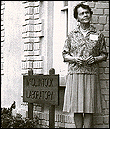|
 Previous Event | Next Event Previous Event | Next Event 
1944: Jumping Genes
 Barbara McClintock discovers that genes can jump around on chromosomes, showing that the genome is more dynamic than previously thought. Barbara McClintock discovers that genes can jump around on chromosomes, showing that the genome is more dynamic than previously thought.
Since the studies on genetic linkage in Drosophila conducted in Morgan’s lab, genes had been considered to have fixed positions on chromosomes. Using corn as her model organism, McClintock observed that genes can "jump" or be transposed from one position to another on chromosomes. She correlated microscopic rearrangements of chromosome segments with the redistribution of genetic traits. This revealed that the genome was much more dynamic than previously thought.
Transposons, or mobile genetic elements, were later found in all kinds of species, from bacteria to humans. McClintock was awarded the Nobel Prize in Physiology or Medicine in 1983 for the discovery.
 Previous Event | Next Event Previous Event | Next Event 
Last Updated: April 7, 2008
|

